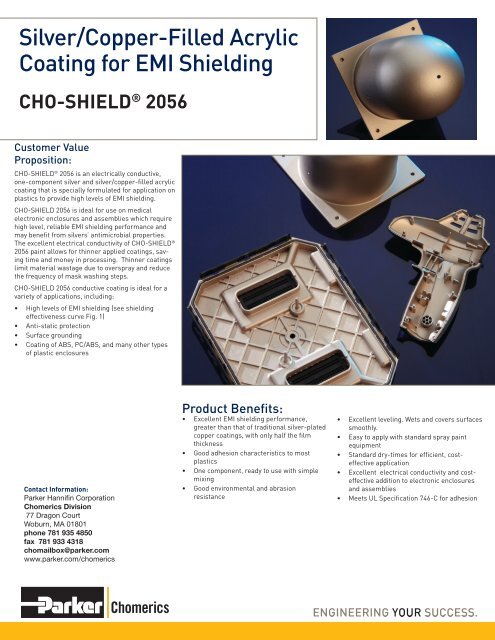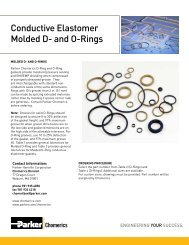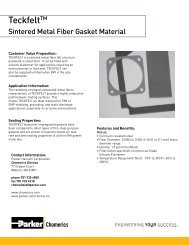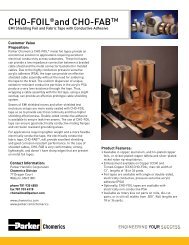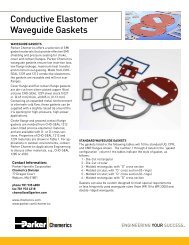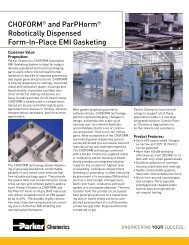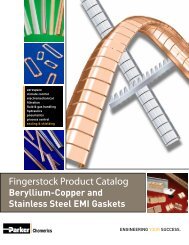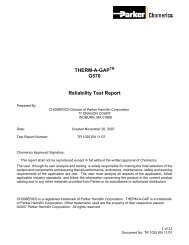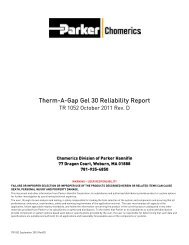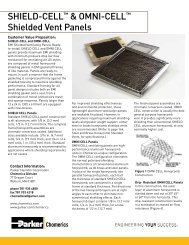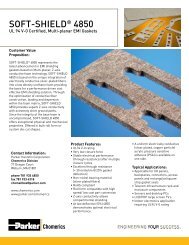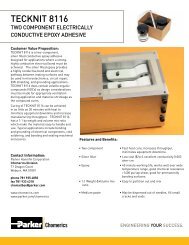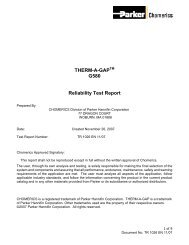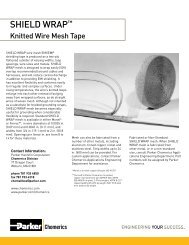Silver/Copper-Filled Acrylic Coating for EMI Shielding - Parker
Silver/Copper-Filled Acrylic Coating for EMI Shielding - Parker
Silver/Copper-Filled Acrylic Coating for EMI Shielding - Parker
Create successful ePaper yourself
Turn your PDF publications into a flip-book with our unique Google optimized e-Paper software.
<strong>Silver</strong>/<strong>Copper</strong>-<strong>Filled</strong> <strong>Acrylic</strong><br />
<strong>Coating</strong> <strong>for</strong> <strong>EMI</strong> <strong>Shielding</strong><br />
CHO-SHIELD ® 2056<br />
Customer Value<br />
Proposition:<br />
CHO-SHIELD ® 2056 is an electrically conductive,<br />
one-component silver and silver/copper-filled acrylic<br />
coating that is specially <strong>for</strong>mulated <strong>for</strong> application on<br />
plastics to provide high levels of <strong>EMI</strong> shielding.<br />
CHO-SHIELD 2056 is ideal <strong>for</strong> use on medical<br />
electronic enclosures and assemblies which require<br />
high level, reliable <strong>EMI</strong> shielding per<strong>for</strong>mance and<br />
may benefit from silvers’ antimicrobial properties.<br />
The excellent electrical conductivity of CHO-SHIELD ®<br />
2056 paint allows <strong>for</strong> thinner applied coatings, saving<br />
time and money in processing. Thinner coatings<br />
limit material wastage due to overspray and reduce<br />
the frequency of mask washing steps.<br />
CHO-SHIELD 2056 conductive coating is ideal <strong>for</strong> a<br />
variety of applications, including:<br />
• High levels of <strong>EMI</strong> shielding (see shielding<br />
effectiveness curve Fig. 1)<br />
• Anti-static protection<br />
• Surface grounding<br />
• <strong>Coating</strong> of ABS, PC/ABS, and many other types<br />
of plastic enclosures<br />
Contact In<strong>for</strong>mation:<br />
<strong>Parker</strong> Hannifin Corporation<br />
Chomerics Division<br />
77 Dragon Court<br />
Woburn, MA 01801<br />
phone 781 935 4850<br />
fax 781 933 4318<br />
chomailbox@parker.com<br />
www.parker.com/chomerics<br />
Product Benefits:<br />
• Excellent <strong>EMI</strong> shielding per<strong>for</strong>mance,<br />
greater than that of traditional silver-plated<br />
copper coatings, with only half the film<br />
thickness<br />
• Good adhesion characteristics to most<br />
plastics<br />
• One component, ready to use with simple<br />
mixing<br />
• Good environmental and abrasion<br />
resistance<br />
• Excellent leveling. Wets and covers surfaces<br />
smoothly.<br />
• Easy to apply with standard spray paint<br />
equipment<br />
• Standard dry-times <strong>for</strong> efficient, costeffective<br />
application<br />
• Excellent electrical conductivity and costeffective<br />
addition to electronic enclosures<br />
and assemblies<br />
• Meets UL Specification 746-C <strong>for</strong> adhesion
Application<br />
Recommended Preparation<br />
1. Clean the substrate:<br />
The substrate surface should be<br />
clean, dry and free of oils, release<br />
agents, dirt and lint.<br />
2. Mix the material:<br />
Mix the material well on a paint<br />
shaker (typically 1-minute <strong>for</strong><br />
one-gallon can). Or, mix by hand<br />
with a large spatula until all solids<br />
are in a homogeneous suspension.<br />
Check that no unmixed material remains<br />
on the bottom and the sides<br />
of the container.<br />
3. Optional: Strain the material<br />
to reduce or eliminate the potential<br />
<strong>for</strong> clogging the spray nozzle.<br />
The paint can be strained through<br />
a course mesh (1000 micron) flat<br />
strainer into a pressure pot <strong>for</strong><br />
spray. All metal fillers should<br />
be transferred, although a small<br />
amount of filler clusters might be<br />
collected in the strainer.<br />
4. Optional thinning:<br />
Standard thinning can be accomplished<br />
with MEK (methyl ethyl<br />
ketone) solvent.<br />
During humid days (relative humidity<br />
>50% and temperature >85°<br />
F/30°C), use n-Butyl alcohol and<br />
add up to 8 fluid ounces per gallon<br />
of paint to eliminate blushing (a<br />
white tint on the drying surface).<br />
Fluid Delivery System<br />
Use a pressure pot (15 psi, 103 kPa,<br />
typical) with large diameter, paddletype<br />
agitator at low mixing speed to<br />
keep the metal fillers in uni<strong>for</strong>m suspension.<br />
Conventional spray equipment such as<br />
HVLP (High Volume, Low Pressure) or<br />
DeVilbiss EGA 503 with propeller agitator<br />
pressure pots may be used <strong>for</strong> spray<br />
application with approximately 20-50<br />
psi (138-345 kPa) atomizing air. Use<br />
lowest pressure possible.<br />
Re-circulation of the paint from the<br />
mixing pot through the spray gun and<br />
back via a pump delivery system is recommended<br />
<strong>for</strong> greater filler uni<strong>for</strong>mity.<br />
For large volume applications, a robotic<br />
spray system with an HLVP spray gun<br />
should be used to minimize material<br />
loss due to overspray and maximize<br />
paint transfer efficiency. Siphon feed<br />
equipment can be used <strong>for</strong> small or<br />
prototype runs.<br />
Spray Gun and Pressure<br />
Use a standard air gun with approximately<br />
20-50 psi (138-345 kPa) atomizing<br />
air.<br />
A fluid nozzle with an orifice diameter<br />
of 0.040 to 0.070 inch (1.016 to 1.778<br />
mm) is recommended.<br />
To obtain maximum adhesion and<br />
conductivity, dry spraying should be<br />
avoided. Adjust the spray pressure to<br />
achieve a proper wet film.<br />
Nominal Dry Film Thickness<br />
A nominal dry film thickness of 0.001<br />
inches (25 µm, 1 mil) is recommended<br />
to obtain > 75 dB shielding effectiveness<br />
from 80 MHz to 10 GHz. However,<br />
a thinner or thicker coat may be<br />
acceptable depending on the shielding<br />
requirements of the device being<br />
protected.<br />
Allow material to dry 10-20 minutes at<br />
room temperature between coats to<br />
avoid solvent entrapment.<br />
Drying Conditions<br />
1. Dry at room temperature <strong>for</strong><br />
10-20 minutes.<br />
2. Continue drying <strong>for</strong> 30 minutes at<br />
150°F ± 10°F (65°C ± 5.5°C)<br />
<strong>for</strong> 0.001 inches (25 µm, 1 mil)<br />
thickness.<br />
Dry longer if thicker film, shorter<br />
if thinner film, to achieve desired<br />
conductivity.<br />
Note: Drying at room temperature<br />
<strong>for</strong> 24 hours will achieve similar<br />
per<strong>for</strong>mance.<br />
Clean-up<br />
The spray system, including spray<br />
gun, mixing pot, and containers can<br />
be cleaned with MEK or Acetone (VOC<br />
exempt solvent). Masks can be powerwashed<br />
with Challenge 485S barrier<br />
coat.<br />
Storage and Handling<br />
CHO-SHIELD 2056 should be stored<br />
at 50ºF to 86ºF (10ºC to 30ºC) and has<br />
a 12 month shelf life from the date of<br />
manufacturing in the original sealed<br />
container. CHO-SHIELD 2056 is a<br />
flammable liquid. Please consult the<br />
material safety data sheet <strong>for</strong> proper<br />
handling procedures be<strong>for</strong>e use.
Product<br />
In<strong>for</strong>mation<br />
Typical Properties CHO-SHIELD ® 2056<br />
Polymer<br />
<strong>Acrylic</strong><br />
Filler<br />
<strong>Silver</strong>-Plated <strong>Copper</strong> and Pure <strong>Silver</strong> Flakes<br />
<strong>Shielding</strong> Effectiveness<br />
>75 dB (80 MHz - 10 GHz)<br />
Surface Resistance (max.) at 0.001 inches (25 µm, 1 mil)<br />
(CEPS-0002)<br />


